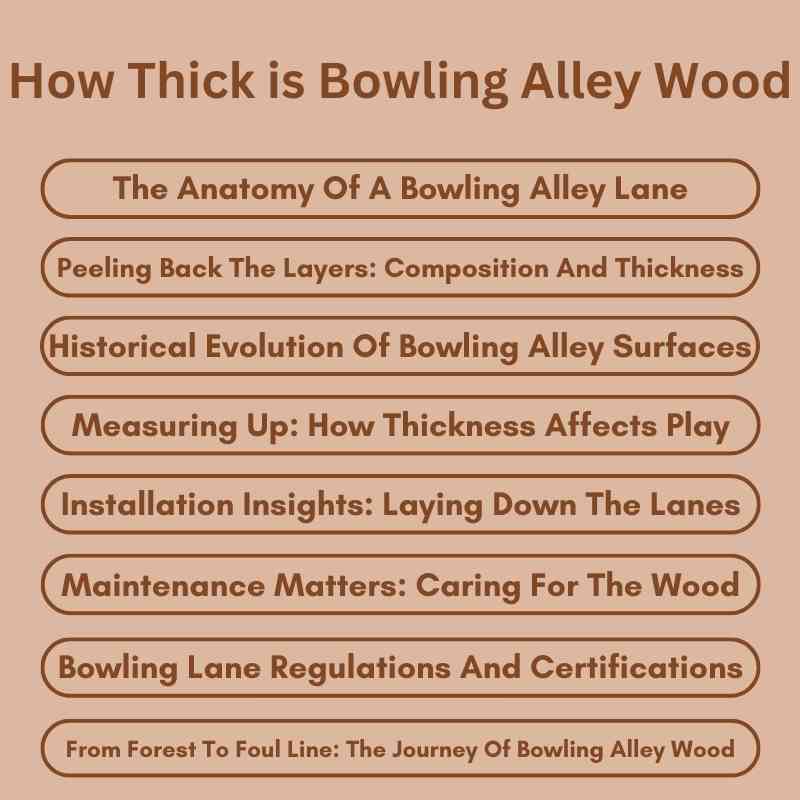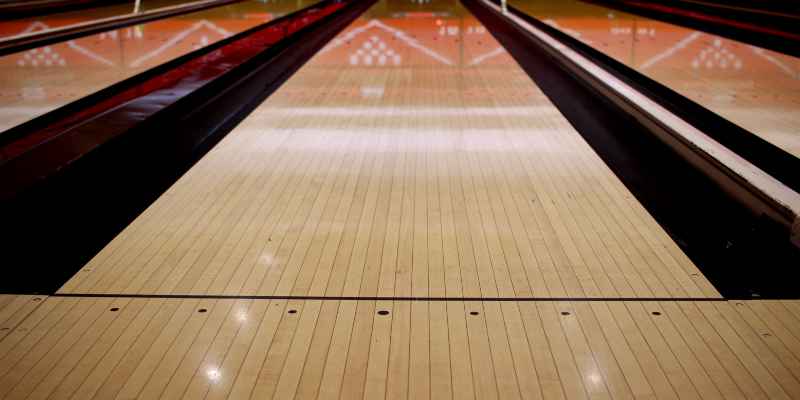Bowling alley wood is typically about 2.5 inches thick. This thickness provides the durability needed for heavy use.
Bowling alleys are crafted from specific types of wood, primarily maple and pine, chosen for their strength and resilience. The thickness of the wood plays a crucial role in the longevity and performance of the lanes. A thicker surface can withstand the impact of bowling balls and the wear from players’ shoes over time.
Proper maintenance of this wood ensures a smooth playing surface, enhancing the bowling experience. Understanding the thickness of bowling alley wood can help enthusiasts appreciate the craftsmanship involved in creating these lanes. Knowing this detail adds depth to your appreciation of the sport and its venues.
The Anatomy Of A Bowling Alley Lane
The construction of a bowling alley lane primarily uses hardwood. This wood is often maple or pine. Maple is strong and durable, making it ideal for the front section. Pine, used in the back, is softer and easier to maintain.
The standard dimensions of a bowling lane are 60 feet long and 41.5 inches wide. The wood thickness typically ranges from 1.5 to 2 inches. This thickness ensures a smooth surface for bowling balls.
Bowling alleys also use synthetic materials. These materials can mimic wood but offer better durability. They are often easier to maintain and have a consistent surface.

Peeling Back The Layers: Composition And Thickness
The bowling alley wood has different layers. The top layer, known as the approach, is crucial for bowlers. It is usually made of hardwood, providing a smooth surface for sliding. This layer typically measures around 1 inch thick.
The foundation layer is the pin deck. This layer is much thicker and can be up to 3 inches. It needs to be sturdy to withstand the impact of bowling balls. Both layers work together to ensure a great experience for players.
Historical Evolution Of Bowling Alley Surfaces
Bowling alleys have changed a lot over the years. Wood was the main material used for lanes. Hardwood like maple and oak was popular for its strength and smoothness.
As time passed, synthetic surfaces became common. These materials are lighter and more durable. They resist scratches and dents better than wood.
Synthetic lanes also allow for easier maintenance. They do not warp or swell with moisture. This makes them a good choice for busy bowling centers.
Overall, the shift from hardwood to synthetic has improved the bowling experience. Bowlers enjoy a consistent and reliable surface every time.
Measuring Up: How Thickness Affects Play
The thickness of bowling alley wood greatly influences ball dynamics. Thicker wood provides better support. This support helps the ball roll more smoothly. A consistent surface leads to better performance for bowlers.
Maintenance is key for a bowling alley’s longevity. Thicker wood can resist wear and tear. This means fewer repairs over time. Regular maintenance keeps the wood in good shape. Proper care ensures a consistent playing experience.
Installation Insights: Laying Down The Lanes
Bowling alley wood is crucial for a smooth game. The thickness of the wood varies but is typically around 2.5 inches. This thickness ensures durability and can withstand heavy use.
The underlayment plays a vital role in installation. It provides cushioning and helps with shock absorption. A good underlayment also improves the longevity of the lanes.
Choosing the right materials is essential. Quality wood and underlayment can enhance the overall performance. Proper installation techniques ensure the lanes remain level and stable over time.
Maintenance Matters: Caring For The Wood
Keeping the bowling alley wood in good shape is very important. A regular cleaning regimen helps maintain the wood’s quality. Use a soft cloth to wipe away dust and debris. Avoid harsh chemicals that can damage the surface.
For resurfacing and restoration, check the wood for any signs of wear. Sand down rough spots carefully. Apply a protective finish to keep the wood smooth and shiny. This process helps the bowling alley last longer and stay appealing.
Following these steps will ensure the wood remains in great condition. Proper care keeps the lanes safe and enjoyable for everyone.
Bowling Lane Regulations And Certifications
Bowling lane wood must meet strict regulations. The United States Bowling Congress (USBC) sets these rules. Lanes should be 42 inches wide and 60 feet long. The wood thickness generally ranges from 1.5 to 2 inches. This thickness helps maintain the lane’s surface and durability.
International specifications also exist. Organizations like World Bowling and Fédération Internationale des Quilleurs (FIQ) establish similar standards. They ensure that bowling lanes are consistent worldwide. Proper wood thickness contributes to a good bowling experience. It affects ball behavior and player performance.
From Forest To Foul Line: The Journey Of Bowling Alley Wood
Bowling alley wood comes from sustainable forests. Companies choose trees like maple and pine for their strength and durability. These trees are harvested carefully to protect the environment. This practice ensures a healthy balance in nature.
The manufacturing process starts with cutting the wood into specific sizes. Workers then sand and finish the wood to make it smooth. After that, the wood is treated to resist wear and tear. This treatment helps the wood last longer in busy bowling alleys.
Bowling lanes are built using thick layers of wood glued together. This method adds strength and stability. The final product is not only functional but also visually appealing.

Frequently Asked Questions
How Thick Is Bowling Alley Wood?
Bowling alley wood typically ranges from 1. 5 to 2 inches in thickness. This thickness ensures durability and optimal performance. The wood needs to withstand heavy impacts from bowling balls. Additionally, this thickness aids in maintaining the lane’s flatness over time.
What Type Of Wood Is Used In Bowling Alleys?
Bowling alleys mainly use maple and pine wood. Maple is often used for the lane surface due to its hardness. Pine is generally used for the lane’s underlying structure. This combination provides the perfect balance of durability and playability for bowlers.
Do Bowling Lanes Have Different Wood Thickness?
Yes, bowling lanes can have varying wood thicknesses. The approach area might be thicker for added stability. In contrast, the lane surface may be thinner for improved gameplay. Such variations help enhance the overall bowling experience.
Why Is Wood Thickness Important For Bowling Alleys?
Wood thickness is crucial for lane performance and longevity. Thicker wood provides better resistance against wear and tear. It also helps maintain consistent lane conditions for bowlers. This ensures a high-quality experience for both casual and competitive players.
Conclusion
Bowling alley wood thickness plays a crucial role in performance and durability. Understanding these measurements can enhance your bowling experience. Whether you’re a casual bowler or a serious competitor, knowing the specifics can help you choose the right alley. Invest time in learning more about bowling alley wood to improve your game.

